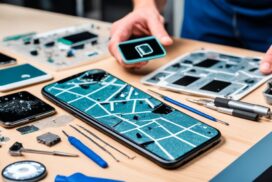Cell Phone Accessibility Feature Repairs for Inclusive Use
Cell phones have become an indispensable tool in our daily lives, providing easy access to communication, information, and various services. However, not everyone can fully utilize these devices due to disabilities or accessibility challenges. This article explores the importance of Cell Phone Accessibility Repair and the need for professional repair services to ensure inclusive technology use for everyone.
As cell phone accessibility features become more advanced, they offer a lifeline to individuals with disabilities. These features include text-to-speech, voice control and magnification options, empowering users to navigate their devices with ease. But what happens when these features malfunction or break?
That’s where Cell Phone Accessibility Repair services step in. These specialized repair services focus on rectifying accessibility issues, ensuring that individuals with disabilities can continue to benefit from the full range of cell phone accessibility features.
Whether it’s fixing a broken screen, resolving software issues, or repairing specific accessibility features, professional repair services have the expertise and knowledge to address these concerns. They work diligently to ensure that cell phones are accessible and functional for individuals with disabilities, allowing them to stay connected, informed, and engaged in the digital world.
Investing in Cell Phone Accessibility Repair not only benefits individuals with disabilities but also promotes inclusive technology use in our society. By recognizing the importance of accessibility and taking action to address any barriers, we can create a more equal and inclusive world for all.
The Impact of Cell Phone Accessibility
Cell phones and mobile technology have experienced remarkable adoption worldwide, penetrating both developed and developing countries. However, many businesses overlook the importance of cell phone accessibility, leading to a lack of inclusion for the disabled community. This disregard for inclusive technology is a missed opportunity, considering that the disabled community represents a lucrative market worth trillions of dollars. By prioritizing cell phone accessibility, businesses can seize the chance to pioneer a new era of inclusion and cater to a wider audience.
As technology continues to advance, it is essential that companies recognize the significance of inclusive design and consider the needs of disabled individuals in their products and services. By implementing accessible features, such as enlarged text, voice assistants, and alternative input methods, cell phones can become powerful tools for the disabled community, empowering them to fully engage in the digital world.
Moreover, embracing cell phone accessibility goes beyond meeting legal requirements or fulfilling social responsibilities. It opens doors to innovation and growth, as companies that prioritize inclusivity can tap into the vast potential of the disabled market. This proactive approach not only benefits businesses by expanding their customer base but also drives positive social change by breaking down barriers and ensuring equal opportunities for all.
By integrating cell phone accessibility into their strategies, businesses can create a more inclusive society and foster a sense of belonging for disabled individuals. Through collaboration and the continuous enhancement of inclusive technology, we can strive towards a future where everyone can access and benefit from the digital world.
The Role of the Mobile Industry in Accessibility
The mobile and telecommunications industry plays a crucial role in driving accessibility and inclusion. It has the power to shape the future by designing cell phones and services with accessibility at the forefront. By prioritizing accessibility, the industry can lead the way in creating a more equitable digital landscape for all.
One notable company that recognizes the potential to make a positive impact is Verizon. They actively work towards incorporating accessibility into every aspect of their business. By doing so, they set an example for other industry players to follow suit, demonstrating the importance of inclusive technology.
Designing for accessibility not only benefits individuals with disabilities but also drives innovation and progress for everyone. When accessibility is integrated into product design and development, it opens doors to new ideas and solutions that can enhance user experiences for a broader range of users. Inclusive technology allows for equal opportunities, fosters diversity, and promotes a society where everyone can participate fully.
It is vital for the mobile industry to continue championing accessibility as a core value. By collaborating with experts in the field, conducting accessibility audits, and implementing best practices, the industry can ensure that cell phones and services are usable and accessible for all individuals, regardless of their abilities.
The Impact of Inclusive Technology
Inclusive technology has the power to transform lives by breaking down barriers and providing equal opportunities for individuals with disabilities. By embracing accessibility, the mobile industry not only fulfills its social responsibility but also taps into a vast market of consumers who value inclusive products and services.
With the rapid growth of the mobile industry, it is crucial for businesses to recognize the importance of accessibility and incorporate it into their development processes. By doing so, they can tap into the immense potential of the disabled community as a consumer base, resulting in greater market reach and growth opportunities.
By making cell phones and services accessible to all, the mobile industry can pave the way for a future where technology is truly inclusive. This future holds the promise of improved communication, increased independence, and enhanced quality of life for individuals with disabilities. It also puts businesses at the forefront of social responsibility, driving positive change and shaping a more inclusive society.
Table: Key Considerations for the Mobile Industry in Driving Accessibility
| Consideration | Description |
|---|---|
| 1. Inclusive Design | Integrate accessibility features from the initial design phase to ensure a seamless user experience for individuals with disabilities. |
| 2. Education and Awareness | Promote awareness and educate stakeholders about the importance of accessibility and how to incorporate it effectively into products and services. |
| 3. Collaboration | Partner with accessibility experts, disability organizations, and individuals with disabilities to gain insights and address specific accessibility needs. |
| 4. Continuous Improvement | Regularly evaluate and enhance accessibility features based on user feedback and advancements in technology. |
| 5. Compliance with Accessibility Standards | Adhere to international accessibility guidelines, such as the Web Content Accessibility Guidelines (WCAG), to ensure compatibility across different platforms and devices. |
The Power of Smartphones and Tablets for Accessibility
Smartphones and tablets have revolutionized the way we access information and connect with others. These devices offer a wide range of accessibility features that greatly enhance the daily lives of individuals with disabilities, including the blind and partially sighted.
With smartphones and tablets, disabled individuals can now receive emails, make audio and video calls, access the internet, and use various apps. These capabilities provide a sense of independence and inclusion, empowering individuals to fully utilize their potential.
For the blind and partially sighted, smartphones and tablets offer specialized accessibility features such as:
- Screen readers and magnifiers that allow users to interact with their device through spoken feedback and enlarged text.
- High contrast modes and color adjustments to enhance visibility and readability.
- Voice input and dictation for hands-free operation.
- Braille displays and support for refreshable Braille keyboards for tactile interaction.
These features enable individuals with visual impairments to navigate their devices, access information, and communicate effectively, opening up a whole new world of possibilities. Similarly, audio transcription, often integrated into smartphones and tablets, provide real-time conversion of spoken words into text, enabling individuals who are deaf or hard of hearing to actively participate in conversations, access media content, and engage with auditory information easy.
Understanding the features and benefits of smartphones and tablets is crucial for disabled individuals to fully utilize their potential. It allows them to stay connected, access important information, and participate actively in the digital age. The continuous advancements in mobile technology further enhance the accessibility options available, ensuring that smartphones and tablets remain powerful tools for individuals with disabilities.
By embracing the accessibility features of smartphones and tablets, the blind and partially sighted can lead more independent and inclusive lives. These devices empower individuals to navigate the world with greater ease, unleashing their true potential in education, employment, and everyday activities. The ongoing commitment of technology companies to accessibility ensures that smartphones and tablets continue to evolve as invaluable tools for people of all abilities.
Making Smartphones and Tablets Easier to Use
Smartphones and tablets are equipped with built-in accessibility features that can be customized to meet individual needs. These features play a crucial role in enhancing the usability of these devices for people with disabilities. By activating and personalizing these accessibility features, individuals can ensure a more inclusive and seamless user experience.
Some of the key accessibility features include:
- Larger and Bolder Text: For individuals with visual impairments, smartphones and tablets allow the option to increase the font size and make text bold. This helps improve readability and ensures that information is more easily accessible.
- Magnification: A magnification feature allows users to zoom in on the screen, making it easier to view content in greater detail. This feature benefits individuals with low vision or those who require a closer look at specific elements.
- Speech Options: Smartphones and tablets come with speech options that enable users to have text read aloud. This is particularly helpful for individuals with dyslexia or those who have difficulty reading. It allows them to listen to content and carry out tasks without relying solely on visual cues.
While these accessibility features are present on smartphones and tablets by default, they may not always be activated. Some users may require assistance in enabling these settings to fully benefit from them. It is crucial to provide support and guidance to individuals to ensure they can personalize their devices and take advantage of the accessibility features available.
“The accessibility features on smartphones and tablets have significantly improved the user experience for people with disabilities. By customizing these devices to match individual needs, users can enjoy a more independent and inclusive digital experience.” – [Author’s Name]
By prioritizing smartphone and tablet accessibility, we empower disabled individuals to utilize these devices to their fullest potential. These accessibility features foster inclusivity, allowing everyone to stay connected, access information, and engage with digital content effortlessly.
Image Caption: [Image Alt Tag]
Conclusion
Cell phone accessibility repair plays a vital role in ensuring inclusive technology use for everyone. By addressing accessibility issues and providing professional repair services, individuals with disabilities can fully utilize cell phone accessibility features and engage in the digital world. The mobile industry has the power to drive change and pioneer inclusion, creating a more equitable future for all.
It is essential that businesses prioritize accessibility and design products and services that cater to everyone’s needs. By incorporating cell phone accessibility features into their offerings, companies can tap into a significant market and meet the demands of the disabled community.
To truly embrace inclusive technology, it is crucial to recognize the transformative impact that smartphones and tablets have on the lives of disabled individuals. These devices provide a range of accessibility features that empower users, making communication, information access, and daily tasks more accessible. By harnessing these technologies and understanding their benefits, we can bridge the digital divide and promote independence and inclusion for all.
FAQ
What are cell phone accessibility features?
Cell phone accessibility features are built-in settings and functions that are designed to make cell phones more user-friendly and accessible for individuals with disabilities. These features include options like larger text, magnification, and speech options.
How can cell phone accessibility repairs ensure inclusive technology use for everyone?
Cell phone accessibility repairs play a vital role in ensuring inclusive technology use for everyone. By addressing accessibility issues and providing professional repair services, individuals with disabilities can fully utilize cell phone accessibility features and engage in the digital world.
What is the impact of cell phone accessibility?
Cell phone accessibility has a significant impact on promoting inclusive technology use. By considering accessibility in cell phone design and repair services, businesses can cater to the needs of the disabled community, which represents a significant market worth trillions of dollars.
What is the role of the mobile industry in accessibility?
The mobile industry has a crucial role to play in driving accessibility and inclusion. By prioritizing accessibility in the design and development of cell phones and services, the industry can lead the way in creating a more equitable future.
How do smartphones and tablets benefit individuals with disabilities?
Smartphones and tablets offer a wide range of accessibility features that enhance the daily lives of individuals with disabilities. These devices allow for activities like receiving emails, making audio and video calls, accessing the internet, and using various apps, providing a sense of independence and inclusion.
How can smartphones and tablets be made easier to use?
Smartphones and tablets come with built-in accessibility features that can be tailored to individual needs. However, these settings are not always activated by default, and individuals may require support to enable them. Personalizing these devices and making use of their accessibility features can ensure a more seamless and inclusive user experience.












